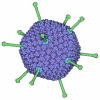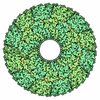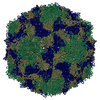+ Open data
Open data
- Basic information
Basic information
| Entry | Database: EMDB / ID: EMD-32194 | |||||||||
|---|---|---|---|---|---|---|---|---|---|---|
| Title | Coxsackievirus B3 (VP3-234Q) incubation with CD55 at pH7.4 | |||||||||
 Map data Map data | ||||||||||
 Sample Sample |
| |||||||||
 Keywords Keywords | CVB3 / VP3-234Q / CD55 / VIRUS | |||||||||
| Function / homology |  Function and homology information Function and homology informationsymbiont-mediated perturbation of host transcription / regulation of lipopolysaccharide-mediated signaling pathway / negative regulation of complement activation / regulation of complement-dependent cytotoxicity / regulation of complement activation / respiratory burst / positive regulation of CD4-positive, alpha-beta T cell activation / positive regulation of CD4-positive, alpha-beta T cell proliferation / Class B/2 (Secretin family receptors) / symbiont-mediated suppression of host cytoplasmic pattern recognition receptor signaling pathway via inhibition of RIG-I activity ...symbiont-mediated perturbation of host transcription / regulation of lipopolysaccharide-mediated signaling pathway / negative regulation of complement activation / regulation of complement-dependent cytotoxicity / regulation of complement activation / respiratory burst / positive regulation of CD4-positive, alpha-beta T cell activation / positive regulation of CD4-positive, alpha-beta T cell proliferation / Class B/2 (Secretin family receptors) / symbiont-mediated suppression of host cytoplasmic pattern recognition receptor signaling pathway via inhibition of RIG-I activity / symbiont-mediated suppression of host cytoplasmic pattern recognition receptor signaling pathway via inhibition of MDA-5 activity / ficolin-1-rich granule membrane / COPI-mediated anterograde transport / complement activation, classical pathway / side of membrane / transport vesicle / endoplasmic reticulum-Golgi intermediate compartment membrane / symbiont-mediated suppression of host cytoplasmic pattern recognition receptor signaling pathway via inhibition of MAVS activity / picornain 2A / symbiont-mediated suppression of host mRNA export from nucleus / symbiont genome entry into host cell via pore formation in plasma membrane / picornain 3C / secretory granule membrane / T=pseudo3 icosahedral viral capsid / Regulation of Complement cascade / host cell cytoplasmic vesicle membrane / endocytosis involved in viral entry into host cell / positive regulation of T cell cytokine production / nucleoside-triphosphate phosphatase / channel activity / virus receptor activity / positive regulation of cytosolic calcium ion concentration / symbiont-mediated suppression of host NF-kappaB cascade / monoatomic ion transmembrane transport / DNA replication / RNA helicase activity / induction by virus of host autophagy / membrane raft / RNA-directed RNA polymerase / Golgi membrane / viral RNA genome replication / cysteine-type endopeptidase activity / innate immune response / RNA-dependent RNA polymerase activity / virus-mediated perturbation of host defense response / lipid binding / DNA-templated transcription / Neutrophil degranulation / host cell nucleus / virion attachment to host cell / structural molecule activity / cell surface / ATP hydrolysis activity / proteolysis / RNA binding / extracellular exosome / extracellular region / ATP binding / membrane / metal ion binding / plasma membrane Similarity search - Function | |||||||||
| Biological species |   Coxsackievirus B3 / Coxsackievirus B3 /  Homo sapiens (human) Homo sapiens (human) | |||||||||
| Method | single particle reconstruction / cryo EM / Resolution: 3.15 Å | |||||||||
 Authors Authors | Wang QL / Liu CC | |||||||||
| Funding support |  China, 1 items China, 1 items
| |||||||||
 Citation Citation |  Journal: Proc Natl Acad Sci U S A / Year: 2022 Journal: Proc Natl Acad Sci U S A / Year: 2022Title: Molecular basis of differential receptor usage for naturally occurring CD55-binding and -nonbinding coxsackievirus B3 strains. Authors: Qingling Wang / Qian Yang / Congcong Liu / Guoqing Wang / Hao Song / Guijun Shang / Ruchao Peng / Xiao Qu / Sheng Liu / Yingzi Cui / Peiyi Wang / Wenbo Xu / Xin Zhao / Jianxun Qi / Mengsu Yang / George F Gao /  Abstract: Receptor usage defines cell tropism and contributes to cell entry and infection. Coxsackievirus B (CVB) engages coxsackievirus and adenovirus receptor (CAR), and selectively utilizes the decay- ...Receptor usage defines cell tropism and contributes to cell entry and infection. Coxsackievirus B (CVB) engages coxsackievirus and adenovirus receptor (CAR), and selectively utilizes the decay-accelerating factor (DAF; CD55) to infect cells. However, the differential receptor usage mechanism for CVB remains elusive. This study identified VP3-234 residues (234Q/N/V/D/E) as critical population selection determinants during CVB3 virus evolution, contributing to diverse binding affinities to CD55. Cryoelectron microscopy (cryo-EM) structures of CD55-binding/nonbinding isolates and their complexes with CD55 or CAR were obtained under both neutral and acidic conditions, and the molecular mechanism of VP3-234 residues determining CD55 affinity/specificity for naturally occurring CVB3 strains was elucidated. Structural and biochemical studies in vitro revealed the dynamic entry process of CVB3 and the function of the uncoating receptor CAR with different pH preferences. This work provides detailed insight into the molecular mechanism of CVB infection and contributes to an in-depth understanding of enterovirus attachment receptor usage. | |||||||||
| History |
|
- Structure visualization
Structure visualization
| Movie |
 Movie viewer Movie viewer |
|---|---|
| Structure viewer | EM map:  SurfView SurfView Molmil Molmil Jmol/JSmol Jmol/JSmol |
| Supplemental images |
- Downloads & links
Downloads & links
-EMDB archive
| Map data |  emd_32194.map.gz emd_32194.map.gz | 84.7 MB |  EMDB map data format EMDB map data format | |
|---|---|---|---|---|
| Header (meta data) |  emd-32194-v30.xml emd-32194-v30.xml emd-32194.xml emd-32194.xml | 20.5 KB 20.5 KB | Display Display |  EMDB header EMDB header |
| FSC (resolution estimation) |  emd_32194_fsc.xml emd_32194_fsc.xml | 15.3 KB | Display |  FSC data file FSC data file |
| Images |  emd_32194.png emd_32194.png | 121.6 KB | ||
| Masks |  emd_32194_msk_1.map emd_32194_msk_1.map | 307.5 MB |  Mask map Mask map | |
| Filedesc metadata |  emd-32194.cif.gz emd-32194.cif.gz | 6.7 KB | ||
| Archive directory |  http://ftp.pdbj.org/pub/emdb/structures/EMD-32194 http://ftp.pdbj.org/pub/emdb/structures/EMD-32194 ftp://ftp.pdbj.org/pub/emdb/structures/EMD-32194 ftp://ftp.pdbj.org/pub/emdb/structures/EMD-32194 | HTTPS FTP |
-Validation report
| Summary document |  emd_32194_validation.pdf.gz emd_32194_validation.pdf.gz | 690.5 KB | Display |  EMDB validaton report EMDB validaton report |
|---|---|---|---|---|
| Full document |  emd_32194_full_validation.pdf.gz emd_32194_full_validation.pdf.gz | 690.1 KB | Display | |
| Data in XML |  emd_32194_validation.xml.gz emd_32194_validation.xml.gz | 14.5 KB | Display | |
| Data in CIF |  emd_32194_validation.cif.gz emd_32194_validation.cif.gz | 19.8 KB | Display | |
| Arichive directory |  https://ftp.pdbj.org/pub/emdb/validation_reports/EMD-32194 https://ftp.pdbj.org/pub/emdb/validation_reports/EMD-32194 ftp://ftp.pdbj.org/pub/emdb/validation_reports/EMD-32194 ftp://ftp.pdbj.org/pub/emdb/validation_reports/EMD-32194 | HTTPS FTP |
-Related structure data
| Related structure data |  7vy5MC  7vxhC  7vxzC  7vy0C  7vy6C  7vykC  7vylC  7vymC  7w14C  7w17C M: atomic model generated by this map C: citing same article ( |
|---|---|
| Similar structure data |
- Links
Links
| EMDB pages |  EMDB (EBI/PDBe) / EMDB (EBI/PDBe) /  EMDataResource EMDataResource |
|---|---|
| Related items in Molecule of the Month |
- Map
Map
| File |  Download / File: emd_32194.map.gz / Format: CCP4 / Size: 307.5 MB / Type: IMAGE STORED AS FLOATING POINT NUMBER (4 BYTES) Download / File: emd_32194.map.gz / Format: CCP4 / Size: 307.5 MB / Type: IMAGE STORED AS FLOATING POINT NUMBER (4 BYTES) | ||||||||||||||||||||||||||||||||||||||||||||||||||||||||||||
|---|---|---|---|---|---|---|---|---|---|---|---|---|---|---|---|---|---|---|---|---|---|---|---|---|---|---|---|---|---|---|---|---|---|---|---|---|---|---|---|---|---|---|---|---|---|---|---|---|---|---|---|---|---|---|---|---|---|---|---|---|---|
| Projections & slices | Image control
Images are generated by Spider. | ||||||||||||||||||||||||||||||||||||||||||||||||||||||||||||
| Voxel size | X=Y=Z: 1.08 Å | ||||||||||||||||||||||||||||||||||||||||||||||||||||||||||||
| Density |
| ||||||||||||||||||||||||||||||||||||||||||||||||||||||||||||
| Symmetry | Space group: 1 | ||||||||||||||||||||||||||||||||||||||||||||||||||||||||||||
| Details | EMDB XML:
CCP4 map header:
| ||||||||||||||||||||||||||||||||||||||||||||||||||||||||||||
-Supplemental data
-Mask #1
| File |  emd_32194_msk_1.map emd_32194_msk_1.map | ||||||||||||
|---|---|---|---|---|---|---|---|---|---|---|---|---|---|
| Projections & Slices |
| ||||||||||||
| Density Histograms |
- Sample components
Sample components
-Entire : Coxsackievirus B3
| Entire | Name:   Coxsackievirus B3 Coxsackievirus B3 |
|---|---|
| Components |
|
-Supramolecule #1: Coxsackievirus B3
| Supramolecule | Name: Coxsackievirus B3 / type: virus / ID: 1 / Parent: 0 / Macromolecule list: #1-#5 / NCBI-ID: 12072 / Sci species name: Coxsackievirus B3 / Virus type: VIRION / Virus isolate: STRAIN / Virus enveloped: No / Virus empty: No |
|---|---|
| Host (natural) | Organism:  Homo sapiens (human) Homo sapiens (human) |
-Macromolecule #1: Capsid protein VP1
| Macromolecule | Name: Capsid protein VP1 / type: protein_or_peptide / ID: 1 / Number of copies: 1 / Enantiomer: LEVO |
|---|---|
| Source (natural) | Organism:   Coxsackievirus B3 Coxsackievirus B3 |
| Molecular weight | Theoretical: 30.167762 KDa |
| Recombinant expression | Organism:  Homo sapiens (human) Homo sapiens (human) |
| Sequence | String: RVADTVGTGP TNSEAIPALT AAETGHTSQV VPGDTMQTRH VKNYHSRSES TIENFLCRSA CVYFTEYENS GAKRYAEWVL TPRQAAQLR RKLEFFTYVR FDLELTFVIT STQQPSTTQN QDAQILTHQI MYVPPGGPVP DKVDSYVWQT STNPSVFWTE G NAPPRMSI ...String: RVADTVGTGP TNSEAIPALT AAETGHTSQV VPGDTMQTRH VKNYHSRSES TIENFLCRSA CVYFTEYENS GAKRYAEWVL TPRQAAQLR RKLEFFTYVR FDLELTFVIT STQQPSTTQN QDAQILTHQI MYVPPGGPVP DKVDSYVWQT STNPSVFWTE G NAPPRMSI PFLSIGNAYS NFYDGWSEFS RNGVYGINTL NNMGTLYARH VNAGSTGPIK STIRIYFKPK HVKAWIPRPP RL CQYEKAK NVNFQPSGVT TTRQSITTMT N UniProtKB: Genome polyprotein |
-Macromolecule #2: Capsid protein VP2
| Macromolecule | Name: Capsid protein VP2 / type: protein_or_peptide / ID: 2 / Number of copies: 1 / Enantiomer: LEVO |
|---|---|
| Source (natural) | Organism:   Coxsackievirus B3 Coxsackievirus B3 |
| Molecular weight | Theoretical: 28.076682 KDa |
| Recombinant expression | Organism:  Homo sapiens (human) Homo sapiens (human) |
| Sequence | String: GYSDRARSIT LGNSTITTQE CANVVVGYGV WPDYLKDSEA TAEDQPTQPD VATCRFYTLD SVQWQKTSPG WWWKLPDALS NLGLFGQNM QYHYLGRTGY TVHVQCNASK FHQGCLLVVC VPEAEMGCAT LDNTPSSAEL LGGDSAKEFA DKPVASGSNK L VQRVVYNA ...String: GYSDRARSIT LGNSTITTQE CANVVVGYGV WPDYLKDSEA TAEDQPTQPD VATCRFYTLD SVQWQKTSPG WWWKLPDALS NLGLFGQNM QYHYLGRTGY TVHVQCNASK FHQGCLLVVC VPEAEMGCAT LDNTPSSAEL LGGDSAKEFA DKPVASGSNK L VQRVVYNA GMGVGVGNLT IFPHQWINLR TNNSATIVMP YTNSVPMDNM FRHNNVTLMV IPFVPLDYCP GSTTYVPITV TI APMCAEY NGLRLAGHQ UniProtKB: Genome polyprotein |
-Macromolecule #3: Capsid protein VP3
| Macromolecule | Name: Capsid protein VP3 / type: protein_or_peptide / ID: 3 / Number of copies: 1 / Enantiomer: LEVO |
|---|---|
| Source (natural) | Organism:   Coxsackievirus B3 Coxsackievirus B3 |
| Molecular weight | Theoretical: 26.227725 KDa |
| Recombinant expression | Organism:  Homo sapiens (human) Homo sapiens (human) |
| Sequence | String: GLPTMNTPGS CQFLTSDDFQ SPSAMPQYDV TPEMRIPGEV KNLMEIAEVD SVVPVQNVGE KVNSMEAYQI PVRSNEGSGT QVFGFPLQP GYSSVFSRTL LGEILNYYTH WSGSIKLTFM FCGSAMATGK FLLAYSPPGA GAPTKRVDAM LGTHVVWDVG L QSSCVLCI ...String: GLPTMNTPGS CQFLTSDDFQ SPSAMPQYDV TPEMRIPGEV KNLMEIAEVD SVVPVQNVGE KVNSMEAYQI PVRSNEGSGT QVFGFPLQP GYSSVFSRTL LGEILNYYTH WSGSIKLTFM FCGSAMATGK FLLAYSPPGA GAPTKRVDAM LGTHVVWDVG L QSSCVLCI PWISQTHYRY VTSDEYTAGG FITCWYQTNI VVPADAQSSC YIMCFVSACN DFSVRLLKDT PFISQQNFFQ UniProtKB: Genome polyprotein |
-Macromolecule #4: Genome polyprotein
| Macromolecule | Name: Genome polyprotein / type: protein_or_peptide / ID: 4 / Number of copies: 1 / Enantiomer: LEVO |
|---|---|
| Source (natural) | Organism:   Coxsackievirus B3 / Strain: Nancy Coxsackievirus B3 / Strain: Nancy |
| Molecular weight | Theoretical: 7.349039 KDa |
| Recombinant expression | Organism:  Homo sapiens (human) Homo sapiens (human) |
| Sequence | String: GAQVSTQKTG AHETGLNASG NSIIHYTNIN YYKDAASNSA NRQDFTQDPG KFTEPVKDIM IKSLPALN UniProtKB: Genome polyprotein |
-Macromolecule #5: Complement decay-accelerating factor
| Macromolecule | Name: Complement decay-accelerating factor / type: protein_or_peptide / ID: 5 / Number of copies: 1 / Enantiomer: LEVO |
|---|---|
| Source (natural) | Organism:  Homo sapiens (human) Homo sapiens (human) |
| Molecular weight | Theoretical: 13.535401 KDa |
| Recombinant expression | Organism:  |
| Sequence | String: CEVPTRLNSA SLKQPYITQN YFPVGTVVEY ECRPGYRREP SLSPKLTCLQ NLKWSTAVEF CKKKSCPNPG EIRNGQIDVP GGILFGATI SFSCNTGYKL FGSTSSFCLI SGSSVQWSDP LPEC UniProtKB: Complement decay-accelerating factor |
-Macromolecule #6: PALMITIC ACID
| Macromolecule | Name: PALMITIC ACID / type: ligand / ID: 6 / Number of copies: 1 / Formula: PLM |
|---|---|
| Molecular weight | Theoretical: 256.424 Da |
| Chemical component information |  ChemComp-PLM: |
-Experimental details
-Structure determination
| Method | cryo EM |
|---|---|
 Processing Processing | single particle reconstruction |
| Aggregation state | particle |
- Sample preparation
Sample preparation
| Buffer | pH: 7.4 |
|---|---|
| Grid | Model: PELCO Ultrathin Carbon with Lacey Carbon / Support film - Material: CARBON / Support film - topology: CONTINUOUS |
| Vitrification | Cryogen name: ETHANE / Chamber humidity: 100 % / Chamber temperature: 277 K / Instrument: FEI VITROBOT MARK IV |
- Electron microscopy
Electron microscopy
| Microscope | FEI TITAN KRIOS |
|---|---|
| Temperature | Min: 70.0 K / Max: 70.0 K |
| Image recording | Film or detector model: FEI FALCON III (4k x 4k) / Detector mode: COUNTING / Digitization - Dimensions - Width: 4096 pixel / Digitization - Dimensions - Height: 4096 pixel / Average exposure time: 1.0 sec. / Average electron dose: 40.0 e/Å2 |
| Electron beam | Acceleration voltage: 300 kV / Electron source:  FIELD EMISSION GUN FIELD EMISSION GUN |
| Electron optics | C2 aperture diameter: 70.0 µm / Calibrated defocus max: 5.0 µm / Calibrated defocus min: 1.8 µm / Illumination mode: FLOOD BEAM / Imaging mode: BRIGHT FIELD / Cs: 2.7 mm / Nominal defocus max: 2.5 µm / Nominal defocus min: 1.5 µm / Nominal magnification: 75000 |
| Sample stage | Specimen holder model: FEI TITAN KRIOS AUTOGRID HOLDER / Cooling holder cryogen: NITROGEN |
| Experimental equipment |  Model: Titan Krios / Image courtesy: FEI Company |
+ Image processing
Image processing
-Atomic model buiding 1
| Initial model |
| ||||||||||
|---|---|---|---|---|---|---|---|---|---|---|---|
| Refinement | Space: REAL / Protocol: RIGID BODY FIT | ||||||||||
| Output model |  PDB-7vy5: |
 Movie
Movie Controller
Controller






























 Z (Sec.)
Z (Sec.) Y (Row.)
Y (Row.) X (Col.)
X (Col.)































